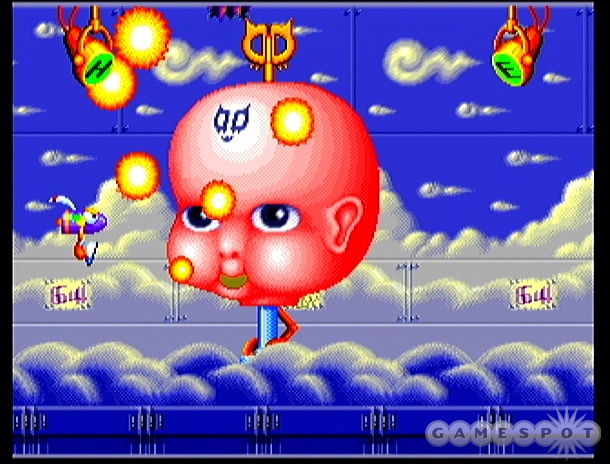Dynamite Headdy has no historical significance apart from the fact that it was one of the last Sega Genesis games published. That's just fine, though, because Headdy is a heroic puppet and he doesn't care about history or accolades. All that matters to him is that you (as Headdy) get to beat the stuffing out of evil puppets and plush animals in his game, which just so happens to be a fun 2D action romp and one of the goofiest games from the 16-bit era.

Headdy gets his name from his weapon of choice: his head. In the game, you use it to bash enemies, move objects, and propel him upward from grapple spots. You can also change heads at frequent intervals to add any of roughly a dozen sweet power-ups to the mix, such as laser blasts, the ability to climb walls, and one that makes Headdy so diminutive that he can fit into tiny passages. Overall, the platforming and enemy bashing are intuitive and fun, and the ability to change heads means that no two play-throughs are the same. Furthermore, since the game was developed by Treasure, you can expect to face off against large, bosslike enemies frequently throughout each of the game's 25 sublevels, in addition to the actual bosses waiting at the end of each world.
Another thing that makes Dynamite Headdy enjoyable is its bizarre premise. Each of the game's 10 overall worlds is a scene in a puppet show. Headdy is a puppet, all of the enemies are puppets and toys, and the backgrounds are constructed to look like stage sets. One of the first bosses you'll face is an angry teddy bear. Next up is a huge plastic wind-up wiener dog. Later on, you'll take to the skies and dogfight with a heavily armed series of ceramic doll heads. Even Headdy's health indicator sticks to the puppet show theme. It's a stage light projecting a big letter "H" that changes color with each subsequent hit. Watching an action game unfold in this manner is quite a ride.
Treasure's programmers also managed to push some amazing graphics and audio out of the Genesis hardware. Headdy bounces along like a determined Pinocchio and has a healthy variety of crazy attack animations. The bosses are huge, enemies frequently splinter apart into tiny pieces, and the multilayered backgrounds often fall apart or change right before your eyes. When you reach the end of a scene, stage hands tear down the set and build a new one for your upcoming battle with that scene's boss, which then usually makes a big entrance by breaking through the set backdrop or crushing something resting on the stage. One level employs a rotation effect to produce three-dimensional platforms that you have to jump between. The slapsticky sound effects and random voice comments fit the goofy presentation, while the accompanying soundtrack is whimsical or harrowing, depending on the situation. However, the most impressive aspect of the music is how rich it is. You'd almost think they shoehorned the Super Nintendo's superior sound chip into the cartridge.

The game's only major flaw is that it's insanely tough to beat. More to the point, the first five worlds are a breeze and everything afterward is sadistic. Extra lives are also rare, and continues are nearly impossible to earn. Still, video games are supposed to be challenging, right? And the action certainly is visceral enough to keep you coming back for more.
Just like all of the other Sega Genesis games that have been made available for the Virtual Console to date, the Wii's emulation of the original code is perfect. The graphics are sharp, the audio is clear, and the Wii Remote lets you jump around and noggin-bash with ease.
Dynamite Headdy hasn't achieved the legendary status that Treasure's earlier run-and-gun romp, Gunstar Heroes, has, in part because Sega originally released Dynamite Headdy in 1994, when the 16-bit consoles had just about run their course. That's a shame, really, considering Headdy's game provides a similarly high level of excitement. If you enjoy 2D action games, don't hesitate to spend the 800 Wii points necessary to download and play Dynamite Headdy.